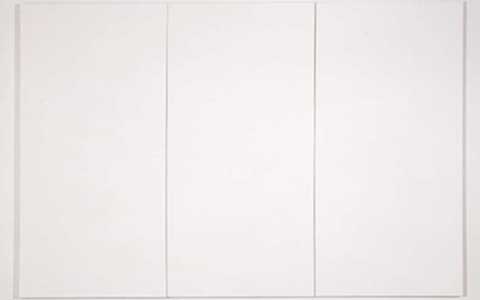
Radar: The Anarchy of Silence

Silent painting: Robert Rauschenberg’s White Painting (Three Panel) (1951)
Barcelona – An exhibition on the life and work of the composer John Cage is running at the Museu D’Art Contemporani De Barcelona until 10 January 2010. It is the first of its kind to place the work of Cage in the context of the historical and artistic context of his time. Visitors to the exhibition walk through the composer’s career decade by decade, beginning with the percussion music of the 1930s, moving on to the prepared piano works of the 1940s, then the chance and indeterminate compositions of the 1950s and finally the multimedia works of the 1960s onwards.
On the walls of each room are originals of many of Cage’s scores, each copied in his own distinctive calligraphy. Headphones are provided so that visitors can walk along the scores while listening to the music.
A number of Cage’s own possessions are also on display: for example, a wooden box of faded brown envelopes, each of which held an individual screw, nail or bolts, which Cage used to prepare his pianos. Each envelope was typewriter marked with instructions on where to place the object on the piano. Nearby there is a Steinway piano, which has been prepared by the curators for this exhibition. (When The Journal of Music visited – on the first day of the exihibition last October, it was not allowed to play the piano, but some children did the sensible thing and played it anyway.)
The curator, Julia Robinson, has placed much emphasis on presenting Cage’s artistic world. Numerous artworks from his friends are shown, including works by Marcel Duchamp, Robert Rauchenberg, whose white paintings (above) are displayed close to the autograph score of Cage’s ‘silent piece’, 4’33”.
Some correspondence shed light on Cage’s dealings with other composers, in particular a young La Monte Young, who in the 1960s would update the New Yorker about what was happening on the West coast (not much, according to Young).
Further salvaged texts include lecture notes taken by the composer and artist George Brecht during one of Cage’s seminal lectures at the New School for Social Research.
Two large-scale installation pieces complete the exhibition – HPSCHD of 1969 and his 1975 Lecture on the Weather, works which the curator claims ‘bring us to the heart of [his] lifelong efforts … built on a foundation of tireless questioning’.
A series of lectures, talks, workshops and screenings is running alongside the exhibition, as well as performances by many of the performers Cage worked with in his lifetime. www.macba.cat
Published on 1 December 2009









